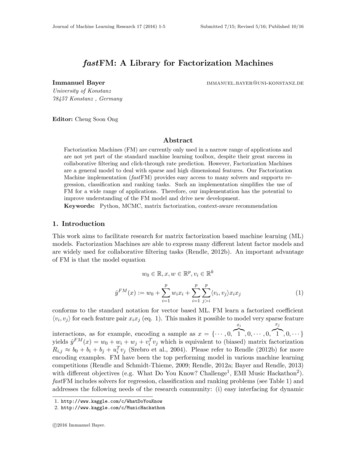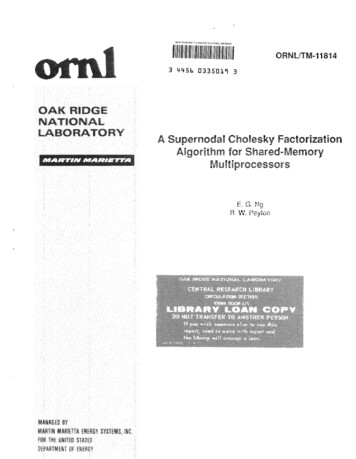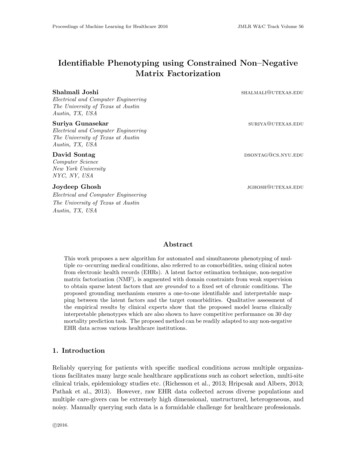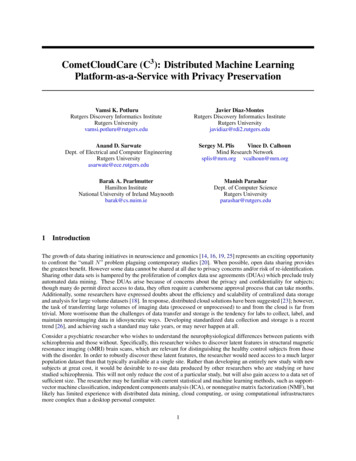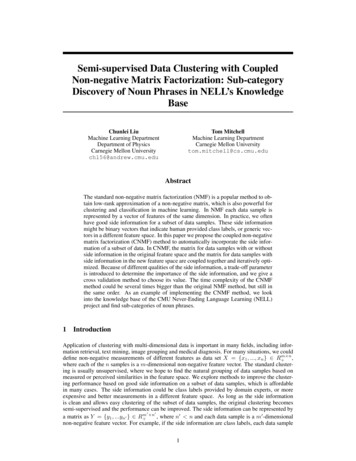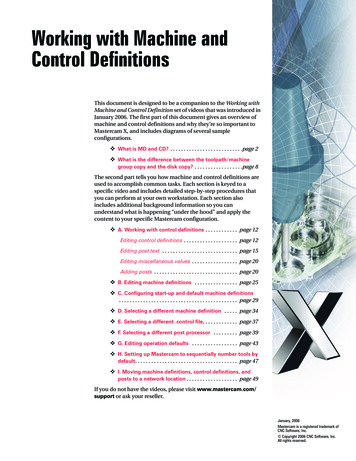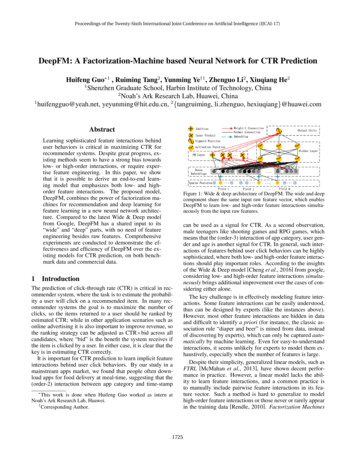
Transcription
Proceedings of the Twenty-Sixth International Joint Conference on Artificial Intelligence (IJCAI-17)DeepFM: A Factorization-Machine based Neural Network for CTR PredictionHuifeng Guo 1 , Ruiming Tang2 , Yunming Ye†1 , Zhenguo Li2 , Xiuqiang He21Shenzhen Graduate School, Harbin Institute of Technology, China2Noah’s Ark Research Lab, Huawei, China1huifengguo@yeah.net, yeyunming@hit.edu.cn, 2 {tangruiming, li.zhenguo, hexiuqiang}@huawei.comAbstractLearning sophisticated feature interactions behinduser behaviors is critical in maximizing CTR forrecommender systems. Despite great progress, existing methods seem to have a strong bias towardslow- or high-order interactions, or require expertise feature engineering. In this paper, we showthat it is possible to derive an end-to-end learning model that emphasizes both low- and highorder feature interactions. The proposed model,DeepFM, combines the power of factorization machines for recommendation and deep learning forfeature learning in a new neural network architecture. Compared to the latest Wide & Deep modelfrom Google, DeepFM has a shared input to its“wide” and “deep” parts, with no need of featureengineering besides raw features. Comprehensiveexperiments are conducted to demonstrate the effectiveness and efficiency of DeepFM over the existing models for CTR prediction, on both benchmark data and commercial data.1Figure 1: Wide & deep architecture of DeepFM. The wide and deepcomponent share the same input raw feature vector, which enablesDeepFM to learn low- and high-order feature interactions simultaneously from the input raw features.IntroductionThe prediction of click-through rate (CTR) is critical in recommender system, where the task is to estimate the probability a user will click on a recommended item. In many recommender systems the goal is to maximize the number ofclicks, so the items returned to a user should be ranked byestimated CTR; while in other application scenarios such asonline advertising it is also important to improve revenue, sothe ranking strategy can be adjusted as CTR bid across allcandidates, where “bid” is the benefit the system receives ifthe item is clicked by a user. In either case, it is clear that thekey is in estimating CTR correctly.It is important for CTR prediction to learn implicit featureinteractions behind user click behaviors. By our study in amainstream apps market, we found that people often download apps for food delivery at meal-time, suggesting that the(order-2) interaction between app category and time-stamp This work is done when Huifeng Guo worked as intern atNoah’s Ark Research Lab, Huawei.†Corresponding Author.1725can be used as a signal for CTR. As a second observation,male teenagers like shooting games and RPG games, whichmeans that the (order-3) interaction of app category, user gender and age is another signal for CTR. In general, such interactions of features behind user click behaviors can be highlysophisticated, where both low- and high-order feature interactions should play important roles. According to the insightsof the Wide & Deep model [Cheng et al., 2016] from google,considering low- and high-order feature interactions simultaneously brings additional improvement over the cases of considering either alone.The key challenge is in effectively modeling feature interactions. Some feature interactions can be easily understood,thus can be designed by experts (like the instances above).However, most other feature interactions are hidden in dataand difficult to identify a priori (for instance, the classic association rule “diaper and beer” is mined from data, insteadof discovering by experts), which can only be captured automatically by machine learning. Even for easy-to-understandinteractions, it seems unlikely for experts to model them exhaustively, especially when the number of features is large.Despite their simplicity, generalized linear models, such asFTRL [McMahan et al., 2013], have shown decent performance in practice. However, a linear model lacks the ability to learn feature interactions, and a common practice isto manually include pairwise feature interactions in its feature vector. Such a method is hard to generalize to modelhigh-order feature interactions or those never or rarely appearin the training data [Rendle, 2010]. Factorization Machines
Proceedings of the Twenty-Sixth International Joint Conference on Artificial Intelligence (IJCAI-17)(FM) [Rendle, 2010] model pairwise feature interactions asinner product of latent vectors between features and showvery promising results. While in principle FM can modelhigh-order feature interaction, in practice usually only order2 feature interactions are considered due to high complexity.As a powerful approach to learning feature representation, deep neural networks have the potential to learn sophisticated feature interactions. Some ideas extend CNNand RNN for CTR predition [Liu et al., 2015; Zhang etal., 2014], but CNN-based models are biased to the interactions between neighboring features while RNN-basedmodels are more suitable for click data with sequential dependency. [Zhang et al., 2016] studies feature representations and proposes Factorization-machine supported NeuralNetwork (FNN). This model pre-trains FM before applyingDNN, thus limited by the capability of FM. Feature interaction is studied in [Qu et al., 2016], by introducing a product layer between embedding layer and fully-connected layer,and proposing the Product-based Neural Network (PNN). Asnoted in [Cheng et al., 2016], PNN and FNN, like other deepmodels, capture little low-order feature interactions, whichare also essential for CTR prediction. To model both lowand high-order feature interactions, [Cheng et al., 2016] proposes an interesting hybrid network structure (Wide & Deep)that combines a linear (“wide”) model and a deep model. Inthis model, two different inputs are required for the “widepart” and “deep part”, respectively, and the input of “widepart” still relies on expertise feature engineering.One can see that existing models are biased to low- or highorder feature interaction, or rely on feature engineering. Inthis paper, we show it is possible to derive a learning modelthat is able to learn feature interactions of all orders in an endto-end manner, without any feature engineering besides rawfeatures. Our main contributions are summarized as follows:clicked the item, and y 0 otherwise). χ may include categorical fields (e.g., gender, location) and continuous fields(e.g., age). Each categorical field is represented as a vector of one-hot encoding, and each continuous field is represented as the value itself, or a vector of one-hot encoding after discretization. Then, each instance is converted to (x, y)where x [xf ield1 , xf ield2 , ., xf iledj , ., xf ieldm ] is a ddimensional vector, with xf ieldj being the vector representation of the j-th field of χ. Normally, x is high-dimensionaland extremely sparse. The task of CTR prediction is to build aprediction model ŷ CT R model(x) to estimate the probability of a user clicking a specific app in a given context.2.1DeepFMWe aim to learn both low- and high-order feature interactions.To this end, we propose a Factorization-Machine based neural network (DeepFM). As depicted in Figure 11 , DeepFMconsists of two components, FM component and deep component, that share the same input. For feature i, a scalar wiis used to weigh its order-1 importance, a latent vector Vi isused to measure its impact of interactions with other features.Vi is fed in FM component to model order-2 feature interactions, and fed in deep component to model high-order featureinteractions. All parameters, including wi , Vi , and the network parameters (W (l) , b(l) below) are trained jointly for thecombined prediction model:ŷ sigmoid(yF M yDN N ),(1)where ŷ (0, 1) is the predicted CTR, yF M is the output ofFM component, and yDN N is the output of deep component.FM Component We propose a new neural network model DeepFM(Figure 1) that integrates the architectures of FM anddeep neural networks (DNN). It models low-order feature interactions like FM and models high-order feature interactions like DNN. Unlike the wide & deepmodel [Cheng et al., 2016], DeepFM can be trained endto-end without any feature engineering. DeepFM can be trained efficiently because its wide partand deep part, unlike [Cheng et al., 2016], share thesame input and also the embedding vector. In [Cheng etal., 2016], the input vector can be of huge size as it includes manually designed pairwise feature interactionsin the input vector of its wide part, which also greatlyincreases its complexity. We evaluate DeepFM on both benchmark data and commercial data, which shows consistent improvement overexisting models for CTR prediction.2Our ApproachSuppose the data set for training consists of n instances(χ, y), where χ is an m-fields data record usually involvinga pair of user and item, and y {0, 1} is the associated label indicating user click behaviors (y 1 means the user1726Figure 2: The architecture of FM.The FM component is a factorization machine, whichis proposed in [Rendle, 2010] to learn feature interactionsfor recommendation. Besides a linear (order-1) interactionsamong features, FM models pairwise (order-2) feature interactions as inner product of respective feature latent vectors.1In all figures of this paper, a Normal Connection in black refersto a connection with weight to be learned; a Weight-1 Connection,red arrow, is a connection with weight 1 by default; Embedding,blue dashed arrow, means a latent vector to be learned; Additionmeans adding all input together; Product, including Inner- andOuter-Product, means the output of this unit is the product of twoinput vector; Sigmoid Function is used as the output function inCTR prediction; Activation Functions, such as relu and tanh, areused for non-linearly transforming the signal;The yellow and bluecircles in the sparse features layer represent one and zero in one-hotencoding of the input, respectively.
Proceedings of the Twenty-Sixth International Joint Conference on Artificial Intelligence (IJCAI-17)It can capture order-2 feature interactions much more effectively than previous approaches especially when the dataset issparse. In previous approaches, the parameter of an interaction of features i and j can be trained only when feature i andfeature j both appear in the same data record. While in FM, itis measured via the inner product of their latent vectors Vi andVj . Thanks to this flexible design, FM can train latent vectorVi (Vj ) whenever i (or j) appears in a data record. Therefore,feature interactions, which are never or rarely appeared in thetraining data, are better learnt by FM.As Figure 2 shows, the output of FM is the summation ofan Addition unit and a number of Inner Product units:yF M hw, xi ddXXhVi , Vj i xi · xj ,(2)i 1 j i 1where w Rd and Vi Rk (k is given)2 . The Additionunit (hw, xi) reflects the importance of order-1 features, andthe Inner Product units represent the impact of order-2 featureinteractions.Figure 4: The structure of the embedding layertheir embeddings are of the same size (k); 2) the latent feature vectors (V ) in FM now serve as network weights whichare learned and used to compress the input field vectors to theembedding vectors. In [Zhang et al., 2016], V is pre-trainedby FM and used as initialization. In this work, rather than using the latent feature vectors of FM to initialize the networksas in [Zhang et al., 2016], we include the FM model as part ofour overall learning architecture, in addition to the other DNNmodel. As such, we eliminate the need of pre-training by FMand instead jointly train the overall network in an end-to-endmanner. Denote the output of the embedding layer as:a(0) [e1 , e2 , ., em ],(3)where ei is the embedding of i-th field and m is the numberof fields. Then, a(0) is fed into the deep neural network, andthe forward process is:Deep Componenta(l 1) σ(W (l) a(l) b(l) ),(4)(l)Figure 3: The architecture of DNN.The deep component is a feed-forward neural network,which is used to learn high-order feature interactions. Asshown in Figure 3, a data record (a vector) is fed into the neural network. Compared to neural networks with image [Heet al., 2016] or audio [Boulanger-Lewandowski et al., 2013]data as input, which is purely continuous and dense, the input of CTR prediction is quite different, which requires anew network architecture design. Specifically, the raw feature input vector for CTR prediction is usually highly sparse3 ,super high-dimensional4 , categorical-continuous-mixed, andgrouped in fields (e.g., gender, location, age). This suggestsan embedding layer to compress the input vector to a lowdimensional, dense real-value vector before further feedinginto the first hidden layer, otherwise the network can be overwhelming to train.Figure 4 highlights the sub-network structure from the input layer to the embedding layer. We would like to point outthe two interesting features of this network structure: 1) whilethe lengths of different input field vectors can be different,2We omit a constant offset for simplicity.Only one entry is non-zero for each field vector.4E.g., in an app store of billion users, the one field vector for userID is already of billion dimensions.31727where l is the layer depth and σ is an activation function. a ,W (l) , b(l) are the output, model weight, and bias of the l-thlayer. After that, a dense real-value feature vector is generated, which is finally fed into the sigmoid function for CTRprediction: yDN N W H 1 · a H b H 1 , where H isthe number of hidden layers.It is worth pointing out that FM component and deep component share the same feature embedding, which brings twoimportant benefits: 1) it learns both low- and high-order feature interactions from raw features; 2) there is no need for expertise feature engineering of the input, as required in Wide& Deep [Cheng et al., 2016].2.2Relationship with Other Neural NetworksInspired by the enormous success of deep learning in various applications, several deep models for CTR predictionare developed recently. This section compares the proposedDeepFM with existing deep models for CTR prediction.FNNAs Figure 5 (left) shows, FNN is a FM-initialized feedforward neural network [Zhang et al., 2016]. The FM pretraining strategy results in two limitations: 1) the embeddingparameters might be over affected by FM; 2) the efficiency isreduced by the overhead introduced by the pre-training stage.In addition, FNN captures only high-order feature interactions. In contrast, DeepFM needs no pre-training and learnsboth high- and low-order feature interactions.PNNFor the purpose of capturing high-order feature interactions,PNN imposes a product layer between the embedding layerand the first hidden layer [Qu et al., 2016]. According to
Proceedings of the Twenty-Sixth International Joint Conference on Artificial Intelligence (IJCAI-17)Figure 5: The architectures of existing deep models for CTR prediction: FNN, PNN, Wide & Deep ModelTable 1: Comparison of deep models for CTR predictionFNNPNNWide & DeepDeepFMNoPre-training High-orderFeatures Low-orderFeatures 3.1No FeatureEngineering different types of product operation, there are three variants:IPNN, OPNN, and PNN , where IPNN is based on innerproduct of vectors, OPNN is based on outer product, andPNN is based on both inner and outer products. Like FNN,all PNNs ignore low-order feature interactions.Wide & DeepWide & Deep (Figure 5 (right)) is proposed by Google tomodel low- and high-order feature interactions simultaneously. As shown in [Cheng et al., 2016], there is a need for expertise feature engineering on the input to the “wide” part (forinstance, cross-product of users’ install apps and impressionapps in app recommendation). In contrast, DeepFM needsno such expertise knowledge to handle the input by learningdirectly from the input raw features.A straightforward extension to this model is replacing LRby FM (we also evaluate this extension in Section 3). Thisextension is similar to DeepFM, but DeepFM shares the feature embedding between the FM and deep component. Thesharing strategy of feature embedding influences (in backpropagate manner) the feature representation by both lowand high-order feature interactions, which models the representation more precisely.SummarizationsTo summarize, the relationship between DeepFM and theother deep models in four aspects is presented in Table 1. Ascan be seen, DeepFM is the only model that requires no pretraining and no feature engineering, and captures both lowand high-order feature interactions.3ExperimentsIn this section, we compare our proposed DeepFM and theother state-of-the-art models empirically. The evaluation result indicates that our proposed DeepFM is more effectivethan any other state-of-the-art model and the efficiency ofDeepFM is comparable to the best ones among all the deepmodels.1728Experiment SetupDatasetsWe evaluate the effectiveness and efficiency of our proposedDeepFM on the following two datasets.1) Criteo Dataset: Criteo dataset 5 includes 45 million users’click records. There are 13 continuous features and 26 categorical ones. We split the dataset into two parts: 90% is fortraining, while the rest 10% is for testing.2) Company Dataset: In order to verify the performance ofDeepFM in real industrial CTR prediction, we conduct experiment on Company dataset. We collect 7 consecutive daysof users’ click records from the game center of the Company App Store for training, and the next 1 day for testing. Thereare around 1 billion records in the whole collected dataset.In this dataset, there are app features (e.g., identification, category, and etc), user features (e.g., user’s downloaded apps,and etc), and context features (e.g., operation time, and etc).Evaluation MetricsWe use two evaluation metrics in our experiments: AUC(Area Under ROC) and Logloss (cross entropy).Model ComparisonWe compare 9 models in our experiments: LR, FM, FNN,PNN (three variants), Wide & Deep (two variants), andDeepFM. In the Wide & Deep model, for the purpose of eliminating feature engineering effort, we also adapt the originalWide & Deep model by replacing LR by FM as the wide part.In order to distinguish these two variants of Wide & Deep, wename them LR & DNN and FM & DNN, respectively.6Parameter SettingsTo evaluate the models on Criteo dataset, we follow the parameter settings in [Qu et al., 2016] for FNN and PNN: (1)dropout: 0.5; (2) network structure: 400-400-400; (3) optimizer: Adam; (4) activation function: tanh for IPNN, relu forother deep models. To be fair, our proposed DeepFM usesthe same setting. The optimizers of LR and FM are FTRLand Adam respectively, and the latent dimension of FM is 10.To achieve the best performance for each individual modelon Company dataset, we conducted carefully parameterstudy, which is discussed in Section displayadvertising-challenge-dataset/6We do not use the Wide & Deep API released by Google, asthe efficiency of that implementation is very low. We implementWide & Deep by ourselves by simplifying it with shared optimizerfor both deep and wide part.
Proceedings of the Twenty-Sixth International Joint Conference on Artificial Intelligence (IJCAI-17)3.2Table 2: Performance on CTR prediction.Performance EvaluationIn this section, we evaluate the models listed in Section 3.1 onthe two datasets to compare their effectiveness and efficiency.Efficiency ComparisonThe efficiency of deep learning models is important to realworld applications. We compare the efficiency of different models on Criteo dataset by the following formula: training time of deep CT R model . The results are shown in training time of LR Figure 6, including the tests on CPU (left) and GPU (right),where we have the following observations: 1) pre-trainingof FNN makes it less efficient; 2) Although the speed up ofIPNN and PNN on GPU is higher than the other models,they are still computationally expensive because of the inefficient inner product operations; 3) The DeepFM achievesalmost the most efficient in both tests.Figure 6: Time comparison.Effectiveness ComparisonThe performance for CTR prediction of different models onCriteo dataset and Company dataset is shown in Table 2(note that the numbers in the table are averaged by 5 runs oftraining-testing, and the variances of AUC and Logloss are inthe order of 1E-5), where we have the following observations: Learning feature interactions improves the performanceof CTR prediction model. This observation is from thefact that LR (which is the only model that does not consider feature interactions) performs worse than the othermodels. As the best model, DeepFM outperforms LRby 0.82% and 2.6% in terms of AUC (1.1% and 4.0% interms of Logloss) on Company and Criteo datasets. Learning high- and low-order feature interactions simultaneously and properly improves the performanceof CTR prediction model. DeepFM outperforms themodels that learn only low-order feature interactions(namely, FM) or high-order feature interactions (namely,FNN, IPNN, OPNN, PNN ). Compared to the secondbest model, DeepFM achieves more than 0.34% and0.41% in terms of AUC (0.34% and 0.76% in terms ofLogloss) on Company and Criteo datasets. Learning high- and low-order feature interactions simultaneously while sharing the same feature embedding for high- and low-order feature interactions learning improves the performance of CTR prediction model.DeepFM outperforms the models that learn high- andlow-order feature interactions using separate feature embeddings (namely, LR & DNN and FM & DNN). Compared to these two models, DeepFM achieves more than0.48% and 0.44% in terms of AUC (0.58% and 0.80%in terms of Logloss) on Company and Criteo datasets.1729LRFMFNNIPNNOPNNPNN LR & DNNFM & DNNDeepFMCompany AUCLogLoss0.8641 0.026480.8679 0.026320.8684 0.026280.8662 0.026390.8657 0.026400.8663 0.026380.8671 0.026350.8658 0.026390.8715 0.02619CriteoAUCLogLoss0.7804 0.467820.7894 0.460590.7959 0.463500.7971 0.453470.7981 0.452930.7983 0.453300.7858 0.465960.7980 0.453430.8016 0.44985Overall, our proposed DeepFM model beats the competitors by more than 0.34% and 0.35% in terms of AUC andLogloss on Company dataset, respectively. In fact, a smallimprovement in offline AUC evaluation is likely to lead to asignificant increase in online CTR. As reported in [Cheng etal., 2016], compared with LR, Wide & Deep improves AUCby 0.275% (offline) and the improvement of online CTR is3.9%. The daily turnover of Company ’s App Store is millions of dollars, therefore even several percents lift in CTRbrings extra millions of dollars each year. Moreover, wealso conduct t-test between our proposed DeepFM and theother compared models. The p-value of DeepFM againstFM & DNN under Logloss metric on Company is less than1.5 10 3 , and the others’ p-values on both datasets are lessthan 10 6 , which indicates that our improvement over existing models is significant.3.3Hyper-Parameter StudyWe study the impact of different hyper-parameters of different deep models, on Company dataset. The order is: 1) activation functions; 2) dropout rate; 3) number of neurons perlayer; 4) number of hidden layers; 5) network shape.Activation FunctionAccording to [Qu et al., 2016], relu and tanh are more suitable for deep models than sigmoid. In this paper, we comparethe performance of deep models when applying relu and tanh.As shown in Figure 7, relu is more appropriate than tanh forall the deep models, except for IPNN. Possible reason is thatrelu induces sparsity.Figure 7: AUC and Logloss comparison of activation functions.DropoutDropout [Srivastava et al., 2014] refers to the probability thata neuron is kept in the network. Dropout is a regularizationtechnique to compromise the precision and the complexity ofthe neural network. We set the dropout to be 1.0, 0.9, 0.8, 0.7,0.6, 0.5. As shown in Figure 8, all the models are able to reach
Proceedings of the Twenty-Sixth International Joint Conference on Artificial Intelligence (IJCAI-17)their own best performance when the dropout is properly set(from 0.6 to 0.9). The result shows that adding reasonablerandomness to model can strengthen model’s robustness.Figure 11: AUC and Logloss comparison of network shape.4Figure 8: AUC and Logloss comparison of dropout.Number of Neurons per LayerWhen other factors remain the same, increasing the numberof neurons per layer introduces complexity. As we can observe from Figure 9, increasing the number of neurons doesnot always bring benefit. For instance, DeepFM performs stably when the number of neurons per layer is increased from400 to 800; even worse, OPNN performs worse when we increase the number of neurons from 400 to 800. This is because an over-complicated model is easy to overfit. In ourdataset, 200 or 400 neurons per layer is a good choice.Figure 9: AUC and Logloss comparison of number of neurons.Number of Hidden LayersAs presented in Figure 10, increasing number of hidden layers improves the performance of the models at the beginning,however, their performance is degraded if the number of hidden layers keeps increasing, because of overfitting.Figure 10: AUC and Logloss comparison of number of layers.Network ShapeWe test four different network shapes: constant, increasing,decreasing, and diamond. When we change the networkshape, we fix the number of hidden layers and the total number of neurons. For instance, when the number of hidden layers is 3 and the total number of neurons is 600, then four different shapes are: constant (200-200-200), increasing (100200-300), decreasing (300-200-100), and diamond (150-300150). As we can see from Figure 11, the “constant” networkshape is empirically better than the other three options, whichis consistent with previous studies [Larochelle et al., 2009].1730Related WorkIn this paper, a new deep neural network is proposed for CTRprediction. The most related domains are CTR prediction anddeep learning in recommender system.CTR prediction plays an important role in recommendersystem [Richardson et al., 2007; Juan et al., 2016]. Besidesgeneralized linear models and FM, a few other models areproposed for CTR prediction, such as tree-based model [He etal., 2014], tensor based model [Rendle and Schmidt-Thieme,2010], support vector machine [Chang et al., 2010], andbayesian model [Graepel et al., 2010].The other related domain is deep learning in recommendersystems. In Section 1 and Section 2.2, several deep learning models for CTR prediction are already mentioned, thuswe do not discuss about them here. Several deep learning models are proposed in recommendation tasks other thanCTR prediction (e.g., [Covington et al., 2016; Salakhutdinov et al., 2007; van den Oord et al., 2013; Wu et al.,2016; Zheng et al., 2016; Wu et al., 2017; Zheng et al.,2017]). [Salakhutdinov et al., 2007; Sedhain et al., 2015;Wang et al., 2015] propose to improve Collaborative Filtering via deep learning. The authors of [Wang and Wang, 2014;van den Oord et al., 2013] extract content feature by deeplearning to improve the performance of music recommendation. [Chen et al., 2016] devises a deep learning network toconsider both image feature and basic feature of display adverting. [Covington et al., 2016] develops a two-stage deeplearning framework for YouTube video recommendation.5ConclusionsIn this paper, we proposed DeepFM, a factorization-machinebased neural network for CTR prediction, to overcome theshortcomings of the state-of-the-art models. DeepFM trainsa deep component and an FM component jointly. It gainsperformance improvement from these advantages: 1) it doesnot need any pre-training; 2) it learns both high- and loworder feature interactions; 3) it introduces a sharing strategy of feature embedding to avoid feature engineering. Theexperiments on two real-world datasets demonstrate that 1)DeepFM outperforms the state-of-the-art models in terms ofAUC and Logloss on both datasets; 2) The efficiency ofDeepFM is comparable to the most efficient deep model inthe state-of-the-art.AcknowledgementThis research was supported in part by NSFC under GrantNo. 61572158, National Key Technology R&D Programof MOST China under Grant No. 2014BAL05B06, Shenzhen Science and Technology Program under Grant No.JSGG20150512145714247 and JCYJ20160330163900579.
Proceedings of the Twenty-Sixth International Joint Conference on Artificial Intelligence (IJCAI-17)References[Boulanger-Lewandowski et al., 2013] Nicolas BoulangerLewandowski, Yoshua Bengio, and Pascal Vincent. Audio chord recognition with recurrent neural networks. InISMIR, pages 335–340, 2013.[Chang et al., 2010] Yin-Wen Chang, Cho-Jui Hsieh, KaiWei Chang, Michael Ringgaard, and Chih-Jen Lin. Training and testing low-degree polynomial data mappings vialinear SVM. JMLR, 11:1471–1490, 2010.[Chen et al., 2016] Junxuan Chen, Baigui Sun, Hao Li,Hongtao Lu, and Xian-Sheng Hua. Deep CTR predictionin display advertising. In MM, 2016.[Cheng et al., 2016] Heng-Tze Cheng,Levent Koc,Jeremiah Harmsen, Tal Shaked, Tushar Chandra,Hrishi Aradhye, Glen Anderson, Greg Corrado, WeiChai, Mustafa Ispir, Rohan Anil, Zakaria Haque, LichanHong, Vihan Jain, Xiaobing Liu, and Hemal Shah. Wide& deep learning for recommender systems.CoRR,abs/1606.07792, 2016.[Covington et al., 2016] Paul Covington, Jay Adams, andEmre Sargin. Deep neural networks for youtube recommendations. In RecSys, pages 191–198, 2016.[Graepel et al., 2010] Thore Graepel, Joaquin QuiñoneroCandela, Thomas Borchert, and Ralf Herbrich. Webscale bayesian click-through rate prediction for sponsoredsearch advertising in microsoft’s bing search engine. InICML, pages 13–20, 2010.[He et al., 2014] Xinran He, Junfeng Pan, Ou Jin, TianbingXu, Bo Liu, Tao Xu, Yanxin Shi, Antoine Atallah, RalfH
ability of a user clicking a specic app in a given context. 2.1 DeepFM We aim to learn both low- and high-order feature interactions. To this end, we propose a Factorization-Machine based neu-ral network (DeepFM). As depicted in Figure 11, DeepFM consists of two components,FM componentanddeep com-ponent, that share the same input. For featurei .
